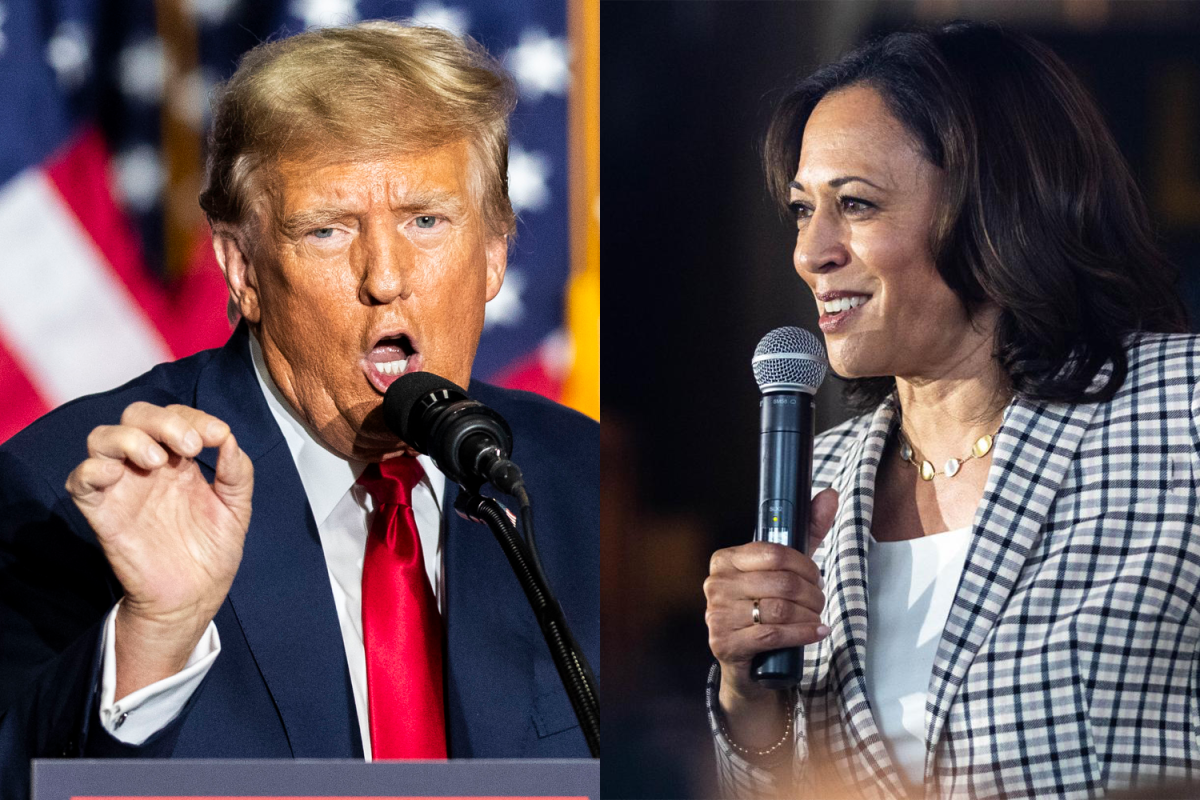Months ago, voters’ collective outlook on the 2024 election wasn’t optimistic. Not many were excited by the impending presidential race. With President Joe Biden and former President Donald Trump hurling towards an unpopular rematch, not many voters were excited to rehash the wounds of just four years earlier.
Polling bore that collective doom out with a January 2024 Reuters/Ipsos poll finding that 67 percent of poll respondents were “tired of seeing the same candidate.”
Voters were dissatisfied with their choices, and Democrats were anxious that Trump would be able to capitalize on disappointment with Biden’s administration and eke out a win.
Those anxieties reared their head just four months later when Biden, 81, fumbled a June 27 debate against Trump. Biden was seen looking confused, freezing mid-sentence, and stumbling over his responses to questions.
The poor debate performance started a media frenzy questioning Biden’s fitness for office, people wondering whether he would be able to fend off Trump’s increasing support.
Democrats, including Iowa’s 1st Congressional District Democratic Candidate Christina Bohannan and 2nd Congressional District Candidate Sarah Corkery, called for Biden to drop out.
Biden announced he would not continue his bid for the White House almost a month after his debate with Trump ended his electoral chances. Within hours, he endorsed his running mate Vice President Kamala Harris to take his place as the Democratic nominee for president of the United States.
The Democratic party quickly coalesced around Harris, nominating her in August at an energy-filled Democratic National Convention in Chicago, Illinois.
Now, with Harris at the helm, Democrats are more excited about the upcoming election. Nationally, nearly eight in ten Democrats say they are more excited than ever to vote in November, according to an August Gallup poll. More voters at-large are excited about voting on Nov. 5 with 69 percent of Gallup poll respondents saying as much. The poll shows that excitement is at the highest it has been since 2000.
This has translated to a transformed race with Harris leading national polling by small margins just weeks before the election, where Biden was behind Trump in the polls. The excitement opens new pathways to victory for Harris in the Electoral College, increasing her chances of winning in November.
Harris’ rise has also changed the race for down-ballot races, like those in Iowa. Cutting into Trump’s lead in the state Harris is only four points behind Trump in Iowa according to a September Des Moines Register/Mediacom poll. Democrats are also more excited in Iowa, with excitement among the party doubling from the June to the September edition of the Iowa poll. Now, more than 80 percent of Iowa Democrats are excited about the upcoming election.
Experts say that Harris’ rising tide could lift Iowa Democrats to electoral success by bolstering excitement at the top of the ticket and bring down-ballot races from Congressional seats to state house races into play. With an exceptionally close race in Iowa’s 1st Congressional District, this changing dynamic could decide the balance of power in the halls of Congress.
However, nationally, the presidential race is still in a dead heat with Harris only leading by three points, according to an October New York Times/Sienna College poll. Harris and Trump are also deadlocked in key swing states that will decide the election, according to October polling from Emerson College.
While the race is currently neck-and-neck, Harris has expanded the map where Biden was unable to. Before Biden’s departure from the race, only Wisconsin, Michigan, and Pennsylvania were considered “tossups,” but with Harris at the helm, she turned Arizona, Nevada, Georgia, and North Carolina into swing states that could go either way — opening more pathways to victory for Harris than Trump.
Harris brings Sun Belt states into play
Harris’s entry into the race expanded the map in states that pollsters previously thought would go to Trump, while Trump has been unable to convert states thought to be blue states into toss-ups.
“Essentially, it makes it harder for Trump to win and easier for her to win, because Trump is not changing what were blue states into tossups for him,” Sara Mitchell, a political science professor at the University of Iowa, said.
The collection of four swing states — Arizona, Nevada, Georgia, and North Carolina — are colloquially known as the “Sun Belt” and open another path to a victory in the Electoral College for Harris.
The states were previously unmovable for Biden, whose lackluster polling and enthusiasm worried Democrats. But under Harris, she has closed in on Trump’s lead in the states, in some surpassing his lead.
October polling by Emerson College found that Harris leads in Nevada and is tied with Trump in Wisconsin and Michigan, with Trump ahead in Pennsylvania, a state considered key in winning the Electoral College.
Candidates need 270 Electoral College votes to win the election. Each state is awarded Electoral College votes based on the number of members of Congress the state has. Forty-eight of the 50 states award Electoral College votes based on who wins the state, with Nebraska and Maine awarding votes based on Congressional districts.
While Harris’ expanded map means more ways to win the Electoral College, Iowa isn’t part of what experts consider a “swing state” despite Harris being only four points behind Trump in the state. Though Iowa Democrats hope that Harris’ tide of enthusiasm could turn into down-ballot success for
the state.
Two Iowa Congressional Districts considered tossups
With Harris closing in on Trump’s lead in Iowa and rising Democratic excitement, Iowa’s 1st and 3rd Congressional Districts are now considered toss-ups by election forecasters, signaling a tight race that could affect the balance of power in Congress.
Iowa’s 1st District is especially close with an October Des Moines Register/Mediacom Iowa Poll finding that a generic Democratic Congressional candidate is preferred by three percentage points to a generic Republican Congressional candidate in the district.
The three-point lead is well within the poll’s margin of error but is the first time a Democrat has taken the lead in a Congressional poll in Iowa this election cycle.
Donna Hoffman, a University of Northern Iowa political science professor, said that the changing dynamics in Iowa’s 1st and 3rd Districts are unsurprising. The districts have a history of being competitive with three of Iowa’s four Congressional seats being held by Democrats as recently as 2018.
The race in Iowa’s 1st Congressional District has been competitive during most of recent political memory. Incumbent U.S. Rep. Mariannette Miller-Meeks, R-Iowa, won her seat in 2020 by only six votes when she ran for a seat vacated by long-time Democratic incumbent Dave Loebsack. In 2022, she won by only seven percentage points over Iowa City Democrat Christina Bohannan, who is running against Miller-Meeks for the second time this election cycle.
“In those kinds of situations, turnout makes and enthusiasm connected to that makes a huge difference,” Hoffman said. “That can make Democratic turnout surge, and down-ballot races can oftentimes benefit from that enthusiasm at the top of the ticket, just like they can be harmed by lacklusterness at the top of the ticket.”
Democrats have looked to capitalize on the changing dynamics in their favor. Iowa’s 1st District started the election cycle as “likely Republican” and has since changed to “toss-up” status, showing favor moving towards Democrats in the district.
Iowa Democratic Party Chair Rita Hart said that the state party has been working to capture the recent uptick in Democratic excitement in the state, which doubled when Harris entered the race, by knocking on hundreds of thousands of doors across the state to turnout results for Democrats in key races.
RELATED: Vice President Kamala Harris reenergizes Democrats after President Joe Biden’s exit
“We’re excited to see what the enthusiasm around the Harris-Walz ticket brings to Iowa,” Hart said in a statement to The Daily Iowan. “We’ve always known that if we can get Democrats to the polls that we have an opportunity for our down-ballot races to get across the finish line. With this enthusiasm, we can make that happen.”
Bohannan said the change in polling reflects the changing dynamics that her team has seen on the ground.
“The truth is that polling really is only useful if it reflects what we’re seeing and feeling on the ground, and we are. For many months now, we have felt that something is happening in Iowa,” Bohannan said in an interview with the DI. “People are ready for change and we have been seeing that appetite for change here for the last year since I got into this race.”
Bohannan said she has seen a large uptick in excitement in the district in just the past few weeks — ever since the race had signaled changing dynamics in polling.
“When they see that this is officially a tossup race, obviously people are getting even more excited and more committed to doing this work and to really getting out the vote here,” Bohannan said. “So we have seen a lot of energy and enthusiasm around this race, especially in these last few weeks, as the race has started to move in our favor and it’s really exciting to see your hard work pay off.”
This increase in excitement could mean electoral results for Iowa Democrats, Hoffmann said, but mostly signal that this election will be tighter than originally predicted from the presidential race down to state house seats that could see a boost from races at the top of the ticket.
“When the dynamics of the race seem to be changing, with more enthusiasm at the national level, you can see that may have a down-ballot effect,” Hoffman said.
Increased enthusiasm could turn into down-ballot success
While increased enthusiasm and Democratic results at the top of the ticket is likely to affect key Congressional races in Iowa, it could also mean results for state house races this election cycle.
Democrats in Iowa’s legislature currently hold a minority with only 36 seats in the 100-person Iowa House of Representatives, and only 16 seats in the 50-person Iowa Senate.
However, state house Democrats could see a boost from excitement for the top-of-the-ticket races.
Hoffman said that with today’s hyper-politicized world, not many voters are voting “split tickets,” or voting for a different party for races at the top of the ticket, like the president, and down-ballot races, like statehouse races. However, with Iowa’s large number of independent voters, it is more common in Iowa than in other states. Pairing a number of swing voters that will vote for Trump and a Democrat for state house, and increased turnout for Democrats, could spell electoral success.
“Having that enthusiasm, which can translate into having more boots on the ground talking to real people, can have a cascading effect to those state-level races that will benefit partisans of the same ticket,” Hoffman said.
Hart said that they expect a number of tight state house races this election cycle and have a higher number of Democrats running for state house seats than previous cycles.
“We are excited that these are quality candidates who have stepped up to run because they are dissatisfied with the extreme laws that have come from the Republican-controlled legislature,” Hart said in a statement to the DI. “Democrats will put people over politics and bring some common sense back to the statehouse that has been lacking with the Republican supermajority that’s currently in power. It’s time to bring common sense back into the halls of government.”

